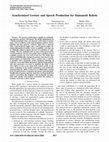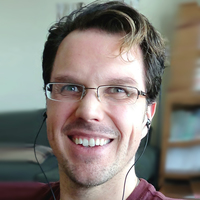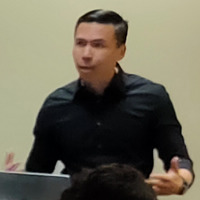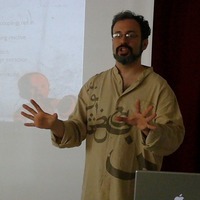Papers by Victor Ng-Thow-Hing
Fig. 8. Six Tyrannosaurus models (in right lateral view) from our sensitivity analysis, represent... more Fig. 8. Six Tyrannosaurus models (in right lateral view) from our sensitivity analysis, representing the extreme high and low values obtained for mass, CM, and inertia. Shown: Model 1 (original 'skinny' model), Model 3 (largest torso), Model 7 (largest torso and legs), Model 21 (largest cavities), Model 27 (largest legs and cavities), and Model 30 ('best guess'). The right hip joint (pink circle; to left) and total body COM with respect to that point (red circle; to right) are indicated, with the x; y; z world axes (right hip joint) and the x; y; z principal axes for inertia calculations (COM) indicated by arrows.
Fig. 2. A B-spline solid is a closed object whose shape can be adjusted by moving control points ... more Fig. 2. A B-spline solid is a closed object whose shape can be adjusted by moving control points (dark points) that deforms the local portion of the object near the control point. The initial cylindrical shape in A is adjusted (B and C) by pulling out the points at the ends and drawing the points in the middle closer to the axis.
Navigation through objects or objects of a display device by means of a first input device for de... more Navigation through objects or objects of a display device by means of a first input device for detecting a finger of the user's view of pointing to an object or object and by a second input means for receiving the indication to the user's selection of the object or of the object. An image of the hand is picked up and processed to determine a location on the display device, corresponding to the location of the finger tip of the pointing finger from the first input device. The object or the object, or the corresponding to the location of the finger tip is selected after the second input device receives a predetermined user input from the second input device.
This contribution presents an approach for representing contactanalog information in an automotiv... more This contribution presents an approach for representing contactanalog information in an automotive Head-Up Display (HUD). Therefore, we will firstly introduce our approach for the calibration of the optical system consisting of the virtual image plane of the HUD and the drivers eyes. Afterward, we will present the used eyetracking system for adaptation of the HUD content at the current viewpoint/position of the driver. We will also present first prototypical concepts for the visualization of contact-analog HUD content and inital test results from a brief usability study.
PhD thesis, University of Toronto, 2001
Anatomically-based models for physical and geometric reconstruction of humans and other animals
Physics-based animation is increasingly being used to create realistic, autonomous animations. Al... more Physics-based animation is increasingly being used to create realistic, autonomous animations. Although commercial systems have been developed that produce passive dynamics, lifelike creatures must have their internal forces and torques for locomotion actively controlled. Other simulation systems are applicable to only one type of object representation like articulated figures or deformable cloth.1
Fig. 7. The six cavities embedded in Tyrannosaurus Model 1's head, neck, and trunk segments, ... more Fig. 7. The six cavities embedded in Tyrannosaurus Model 1's head, neck, and trunk segments, shown in right lateral (A) and dorsal (B) views. 'bc' indicates the buccal cavity; and 'pc' indicates the pharyngeal cavity.

2. Materials and methods<i>2.1. Software implementation and validation</i><i>2.... more 2. Materials and methods<i>2.1. Software implementation and validation</i><i>2.1.1. B-spline solids</i>Our software can create freely deformable body shapes from either 3D coordinate data collected elsewhere as a scaffold around which to build ''fleshed-out'' animal bodies, or from any representative solid geometry. The body of an animal to be studied is partitioned into a set of non-intersecting rigid segments (Fig. 1). Each body segment can consist of one or more <i>mass objects</i> (i.e., parts of the body that have discrete volumes and densities). For example, the trunk segment can have its volume represented as the combination of two mass objects with different densities (one for the lungs and the other representing the surrounding soft tissue and bones). Mathematically, the boundary surface of a B-spline solid is made up of a collection of connected, differentiably, smooth surfaces. To visualize the model and efficiently comp...
Fig. 9. Mass sets used for the Tyrannosaurus turning body analysis; shown for Models 1, 30, and 3.
Fig. 4. Ostrich trunk mass set models: (A) photograph of original trunk carcass in right lateral ... more Fig. 4. Ostrich trunk mass set models: (A) photograph of original trunk carcass in right lateral view, suspended on a cable for CM and inertia estimation experiments; (B) point cloud of carcass landmarks from digitization; (C) B-spline solid shrinkwrapped to fit underlying carcass landmarks (carcass model); (D) photograph of skeleton after defleshing of carcass, (E) point cloud of skeletal landmarks from digitization; (F) B-spline solid shrinkwrapped to fit underlying skeletal landmarks (skeleton model); and (G) Skeleton model with B-spline solid expanded laterally to simulate added flesh (fleshed-out model). Not to scale. The right hip joint (pink and black disk; caudal) and CM (red and black disk; cranial) are shown for the models, with principal axes (arrows). A dotted curve outlines the acetabulum in the carcass and skeleton pictures.
Fig. 1. Body segments can be created using mass objects of different density and shape. Mass obje... more Fig. 1. Body segments can be created using mass objects of different density and shape. Mass objects can be collected into mass sets to calculate their combined inertial properties; the most inclusive Tyrannosaurus mass set (whole body) is outlined here, as well as the trunk segment and its embedded mass objects.
Fig. 5. Tyrannosaurus MOR 555 skeleton: (A) Photograph of mounted skeleton in Berkeley, Californi... more Fig. 5. Tyrannosaurus MOR 555 skeleton: (A) Photograph of mounted skeleton in Berkeley, California (in left lateral view); (B) Torso skeletal landmark points digitized for our study, plus digitized pelvis and leg bones from Hutchinson et al. (2005); and (C, D) additional cranial and caudal photographic views of the skeleton from A.
We introduce the Dynamic Animation and Control Environment (DANCE) as a publicly available simula... more We introduce the Dynamic Animation and Control Environment (DANCE) as a publicly available simulation platform for research and teaching. DANCE is an open and extensible simulation framework and rapid prototyping environment for computer animation. The main focus of the DANCE platform is the development of physicallybased controllers for articulated figures. In this paper we (a) present the architecture and potential applications of DANCE as a research tool, and (b) discuss lessons learned in developing a large framework for animation. Key words: Dynamic animation, graphics system. Figure 1: Two skeletons using different control methods.The left skeleton is key-framed, while the right character responds to physical forces derived from the kinematic motion. Both characters can simultaneously coexist and interact under DANCE. 1
This proxemics study examines whether the physical distance between robots and humans differ base... more This proxemics study examines whether the physical distance between robots and humans differ based on the following factors: 1) age: children vs. adults, 2) who initiates the approach: humans approaching the robot vs. robot approaching humans, 3) prompting: verbal invitation vs. non-verbal gesture (e.g., beckoning), and 4) informing: announcement vs. permission vs. nothing. Results showed that both verbal and non-verbal prompting had significant influence on physical distance. Physiological data is also used to detect the appropriate timing of approach for a more natural and comfortable interaction. Categories and Subject Descriptors H.1.2 [Models and Principles]: User Machine Systems— Software psychology; human factors.
Abstract. This paper presents a motion planner that enables a humanoid robot to push an object on... more Abstract. This paper presents a motion planner that enables a humanoid robot to push an object on a flat surface. The robot’s motion is divided into distinct walking, reaching, and pushing modes. A discrete change of mode can be achieved with a continuous single-mode motion that satisfies mode-specific constraints (e.g. dynamics, kinematic limits, avoid obstacles). Existing techniques can plan well in single modes, but choosing the right mode transitions is difficult. Search-based methods are vastly inefficient due to over-exploration of similar modes. Our new method, Random-MMP, randomly samples mode transitions to distribute a sparse number of modes across configuration space. Results are presented in simulation and on the Honda ASIMO robot. 1

Abstract—We present a model that is capable of synchroniz-ing expressive gestures with speech. Th... more Abstract—We present a model that is capable of synchroniz-ing expressive gestures with speech. The model, implemented on a Honda humanoid robot, can generate a full range of gesture types, such as emblems, iconic and metaphoric gestures, deictic pointing and beat gestures. Arbitrary input text is analyzed with a part-of-speech tagger and a text-to-speech engine for timing information of spoken words. In addition, style tags can be optionally added to specify the level of excitement or topic changes. The text, combined with any tags, is then processed by several grammars, one for each gesture type to produce several candidate gestures for each word of the text. The model then selects probabilistically amongst the gesture types based on the desired degree of expressivity. Once a gesture type is selected, it coincides with a particular gesture template, consisting of trajectory curves that define the gesture. Speech timing patterns and style parameters are used to modulate the shape of...
Anatomically-based models for physical and geometric reconstruction of humans and other animals
The need to model muscles means different things to artistic and technical practitioners. Three d... more The need to model muscles means different things to artistic and technical practitioners. Three different muscle representations are presented and the motivations behind their design are discussed. Each representation allows unique capabilities and operations to be performed on the model, yet the underlying mathematical foundation is the same for all. This is achieved by developing a data-fitting pipeline that allows samples that are generated from different data sources to be used in the guided construction of a B-spline solid. We show how Bspline solids can be used to create muscles from contour curves extracted out of medical images, digitized fibre sets from dissections of muscle specimens, and profile curves that can be interactively sketched and manipulated by an anatomical modeller.











Uploads
Papers by Victor Ng-Thow-Hing